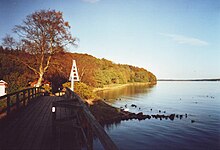Kollunder forest
The Kollund forest ( Danish : Kollund Skov and Flensborg Byskov ) is approximately 130 hectares large timber , which at the Flensburg ( Danish : Flensborg fjord ) between the villages Kruså and Kollund in Denmark is located. The forest has been owned by Den Danske Naturfond since October 2017 .
description
Typical of the Kollunder Forest is a hilly landscape that, like the forests on the German side of the Flensburg Fjord, was shaped by the Vistula Glaciation . In addition to the close proximity to the beach, steep slopes are characteristic of the Kollunder forest.
A mixed deciduous forest by nature , over the centuries people have also planted fast-growing coniferous species here, such as the sitka spruce from North America. In addition to its biodiversity and its proximity to the fjord, the forest offers a well-developed network of trails and serves as a recreational area for both Danish and German citizens. In addition to a small barbecue area, there are numerous benches among the recreational facilities.
The ecologically valuable Krusau tunnel valley and the Klueser forest with the water life recreational forest are also located near the Kollund forest .
History
In the 19th century the Kollund forest was on the verge of being completely cleared . Thereupon the city of Flensburg bought the forest in 1883 on the initiative of Ernst Maria Großheim with the aim of preserving the forest. After the Second World War , all German municipal properties in Denmark were expropriated , with the exception of the Kollunder Forest. 75 hectares of the Kollunder forest were therefore still owned by the city of Flensburg and were managed by the responsible city forester's office. The remaining area belonged to the Danish state or private hands.
In 2006 the City Council of Flensburg decided to sell the Kollunder Forest due to its poor financial situation. A first attempt to sell the forest to the Danish state failed.
The purchase price was estimated at EUR 1.2 million; New prospects were the Flensburg Beautification Association , which tried to finance the purchase price with donations and wanted to prevent a sale to a private person, as well as a Danish businessman. Finally, the Danish private citizen was awarded the contract. Since then, the 75 hectares have been privately owned.
In 2012 the Flensburg voter community failed to vote! with an initiative to have the forest purchased by the city of Flensburg as a total package of 130 hectares at a price of 22.5 million crowns (around 3 million euros).
The organization Den Danske Naturfond acquired the Kollunder Forest in October 2017 and would like to turn it into a limitless natural paradise . The forest is unique in Denmark because its southern location means that it is home to many animal and plant species that are not found in northern parts of the country due to the climate. Den Danske Naturfond has taken over the forest for 16.75 million crowns . The total budget is 20 million crowns. Parts of the forest should remain untouched, other sections will be subjected to renaturation before they too are left to their own devices. With the purchase and the original design of the forest, Naturfond and the municipality of Aabenraa hope to upgrade the 74 km long gendarme path that leads through the Kollund forest.
The upgrading of the Kollund forest through a further development from a coniferous to a deciduous forest and a better experience through an expansion of the network of paths and simple rest and overnight options is to be tackled in 2018.
Others
The Gendarmstien (German: the Gendarmenpfad), now a hiking trail between Padborg and Höruper Haff in the south of the island of Alsen, runs through the Kollunder Forest . Since the unification of North Schleswig with Denmark in 1920, the Gendarmstien served the Danish border gendarmes for patrols. In 1958 this task was transferred to the police.
Another special feature is the Schusterkate border crossing . A small bridge leads from the water life settlement to Danish territory and directly to the Gendarmstien, which leads into the Kollunder forest.
In early 2019, Denmark began protecting its border with Germany against African swine fever with a wild boar fence. The city of Flensburg is of the opinion that a corresponding clause in the sales contract, according to which the city has a right of veto on construction projects even after the sale, applies. The Danish government considers this scheme legally irrelevant because the the Folketing adopted law for the construction of the fence and the concomitant expropriation is for the rights of landowners and former owners.
Web links
Individual evidence
- ↑ Flensborg Byskov and Megalithic. Kollund Skov
- ↑ Der Nordschleswiger: Naturfond bought Kollunder Wald (Kjeld Thomsen), October 4, 2017 , accessed on October 14, 2017
- ↑ Flensburger Tageblatt: Der Retter des Kollunder Waldes (Bernd Philipsen), September 2, 2011 , accessed on October 14, 2017
- ↑ Die Welt: Denmark will not buy Flensburg Forest , accessed on October 12, 2017
- ↑ Flensburger Tageblatt: Forest is looking for buyers - the city waves aside (Gunnar Dommasch), December 21, 2012 , accessed on October 13, 2017
- ↑ Der Nordschleswiger: Naturfond bought Kollunder Wald (Kjeld Thomsen), October 4, 2017 , accessed on October 14, 2017
- ↑ Flensburger Tageblatt: Kollunder Wald near Flensburg - Simplest hostel in the forest (Carlo Jolly), April 23, 2018 , accessed on April 24, 2018
- ↑ Sara Wasmund: Ministry makes it clear: expropriated is expropriated. In: nordschleswiger.dk. April 11, 2019, accessed May 30, 2019 .
Coordinates: 54 ° 50 ′ 18 ″ N , 9 ° 25 ′ 36 ″ E




